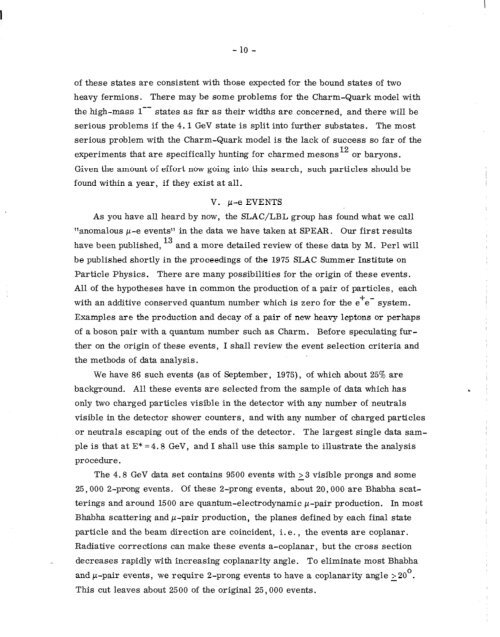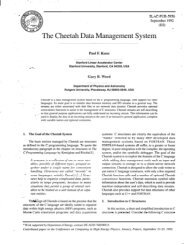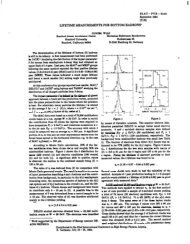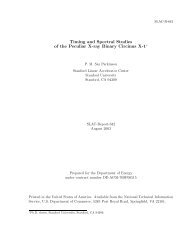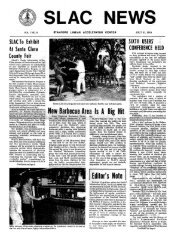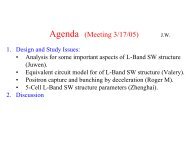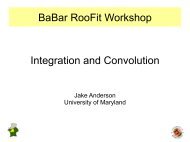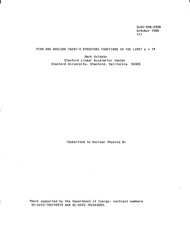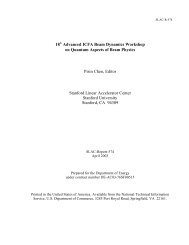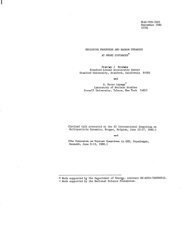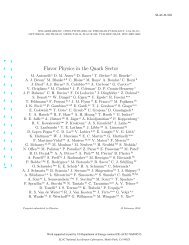SLAC-PUB-1706 - SLAC - Stanford University
SLAC-PUB-1706 - SLAC - Stanford University
SLAC-PUB-1706 - SLAC - Stanford University
Create successful ePaper yourself
Turn your PDF publications into a flip-book with our unique Google optimized e-Paper software.
- 10 -<br />
of these states are consistent with those expected for the bound states of two<br />
heavy fermions. There may be some problems for the Charm-Quark model with<br />
the high-mass l-- states as far as their widths are concerned, and there will be<br />
serious problems if the 4.1 GeV state is split into further substates. The most<br />
serious problem with the Charm-Quark model is the lack of success so far of the<br />
experiments that are specifically hunting for charmed mesons 12 or baryons .<br />
Given the amount of effort now going into this search, such particles should be<br />
found within a year, if they exist at all.<br />
V. 12-e EVENTS<br />
As you have all heard by now, the <strong>SLAC</strong>/LBL group has found what we call<br />
l*anomalous p-e event@ in the data we have taken at SPEAR. Our first results<br />
have been published, 13 and a more detailed review of these data by M. Per1 will<br />
be published shortly in the proceedings of the 1975 <strong>SLAC</strong> Summer Institute on<br />
Particle Physics. There are many possibilities for the origin of these events.<br />
All of the hypotheses have in common the production of a pair of particles, each<br />
with an additive conserved quantum number which is zero for the e+e- system.<br />
Examples are the production and decay of a pair of new heavy leptons or perhaps<br />
of a boson pair with a quantum number such as Charm. Before speculating fur-<br />
ther on the origin of these events, I shall review the event selection criteria and<br />
the methods of data analysis.<br />
We have 86 such events (as of September, 1975)) of which about 25% are<br />
background. All these events are selected from the sample of data which has<br />
only two charged particles visible in the detector with any number of neutrals<br />
visible in the detector shower counters, and with any number of charged particles<br />
or neutrals escaping out of the ends of the detector. The largest single data sam-<br />
ple is that at E* =4.8 GeV, and I shall use this sample to illustrate the analysis<br />
procedure.<br />
The 4.8 GeV data set contains 9500 events with ~3 visible prongs and some<br />
25,000 2-prong events. Of these 2-prong events, about 20,000 are Bhabha scat-<br />
terings and around 1500 are quantum-electrodynamic p-pair production. In most<br />
Bhabha scattering and p-pair production, the planes defined by each final state<br />
particle and the beam direction are coincident, i. e. , the events are coplanar.<br />
Radiative corrections can make these events a-coplanar, but the cross section<br />
decreases rapidly with increasing coplanarity angle. To eliminate most Bhabha<br />
and p-pair events, we require 2-prong events to have a coplanarity angle ~20’.<br />
This cut leaves about 2500 of the original 25,000 events.<br />
L


